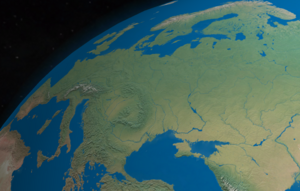
Back Iërupa Timu ACE Oos-Europa AF Osteuropa ALS ምሥራቃዊ አውሮፓ AM Europa de l'Este AN أوروبا الشرقية Arabic اوروبا الشرقيه ARZ Europa Oriental AST Бакъбаккул Европа AV Ronefa Europa AVK

Eastern Europe is a subregion of the European continent. As a largely ambiguous term, it has a wide range of geopolitical, geographical, ethnic, cultural, and socio-economic connotations. Its eastern boundary is marked by the Ural Mountains, whilst its western boundary is defined in various ways.[1] Most definitions include the countries of Belarus, Russia, Ukraine, Moldova, and Romania while less restrictive definitions may also include some or all of the Balkans, the Baltic states, the Caucasus, and the Visegrád group.[2][3]
The region represents a significant part of European culture; the main socio-cultural characteristics of Eastern Europe have historically been defined by the traditions of the East Slavs and Greeks, as well as by the influence of Eastern Christianity as it developed through the Eastern Roman Empire and the Ottoman Empire.[4][5] Another definition was created by the Cold War, as Europe was ideologically divided by the Iron Curtain, with "Eastern Europe" being synonymous with communist states constituting the Eastern Bloc under the influence of the Soviet Union.[5][6][7][8][9][4][10][11]
The term is sometimes considered to be pejorative, through stereotypes about Eastern Europe being inferior (poorer, less developed) to Western Europe; the term Central and Eastern Europe is sometimes used for a more neutral grouping.[12][13][14][15][16]
- ^ "Regions of Europe: Eastern Europe". 10 May 2021. Archived from the original on 25 November 2023. Retrieved 1 June 2023.
- ^ Berglee, Royal (2016). "Traditional Regions of Europe". University of Minnesota. Archived from the original on 2023-12-16. Retrieved 2023-12-15.
- ^ "Geographic Regions". U.N. Statistics Division. Archived from the original on 2017-08-30. Retrieved 2023-10-06.
- ^ a b "United Nations Statistics Division- Standard Country and Area Codes Classifications (M49)-Geographic Regions". Archived from the original on 2017-08-30. Retrieved 2017-08-04.
- ^ a b Ramet, Sabrina P. (1998). Eastern Europe: politics, culture, and society since 1939. Indiana University Press. p. 15. ISBN 978-0253212566. Archived from the original on 30 March 2024. Retrieved 5 October 2011.
- ^ "The Balkans" Archived 10 December 2017 at the Wayback Machine, Global Perspectives: A Remote Sensing and World Issues Site. Wheeling Jesuit University/Center for Educational Technologies, 1999–2002.
- ^ ""Eastern Europe" Wrongly labelled". The Economist. 7 January 2010. Archived from the original on 11 February 2021. Retrieved 20 February 2020.
- ^ "A New Journal for Central Europe". www.ce-review.org. Archived from the original on 31 October 2017. Retrieved 31 August 2009.
- ^ Frank H. Aarebrot (14 May 2014). The handbook of political change in Eastern Europe. Edward Elgar Publishing. pp. 1–. ISBN 978-1-78195-429-4. Archived from the original on 30 March 2024. Retrieved 17 July 2017.
- ^ [1] Archived 3 April 2015 at the Wayback Machine. Eurovoc.europa.eu. Retrieved on 4 March 2015.
- ^ "Population Division, DESA, United Nations: World Population Ageing 1950-2050" (PDF). Archived (PDF) from the original on 2022-10-09.
- ^ Mälksoo, Maria (4 May 2019). "The normative threat of subtle subversion: the return of 'Eastern Europe' as an ontological insecurity trope". Cambridge Review of International Affairs. 32 (3): 365–383. doi:10.1080/09557571.2019.1590314. ISSN 0955-7571. S2CID 159184190. Archived from the original on 2024-03-30. Retrieved 2022-11-16.
- ^ Twardzisz, Piotr (25 April 2018). Defining 'Eastern Europe': A Semantic Inquiry into Political Terminology. Springer. p. 18. ISBN 978-3-319-77374-2. Archived from the original on 2023-06-29. Retrieved 2023-01-03.
- ^ Hall, Derek (July 1999). "Destination branding, niche marketing and national image projection in Central and Eastern Europe". Journal of Vacation Marketing. 5 (3): 227–237. doi:10.1177/135676679900500303. ISSN 1356-7667. S2CID 154698941.
- ^ Zarycki, Tomasz (2014). Ideologies of Eastness in Central and Eastern Europe. doi:10.4324/9781315819006. ISBN 9781317818571. S2CID 129401740. Archived from the original on 2022-11-16. Retrieved 2022-11-16.
- ^ "Eastern promise and Western pretension – DW – 09/07/2018". dw.com. Archived from the original on 2022-11-16. Retrieved 2022-11-16.